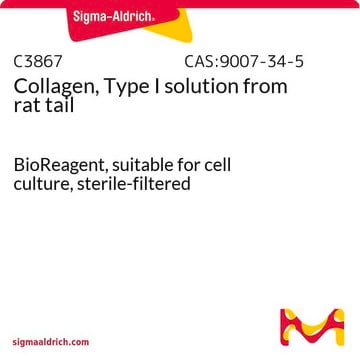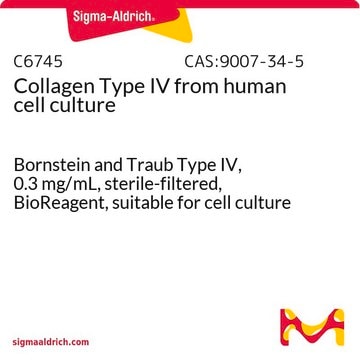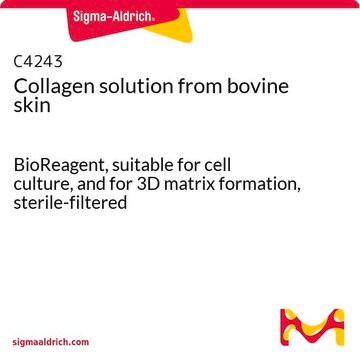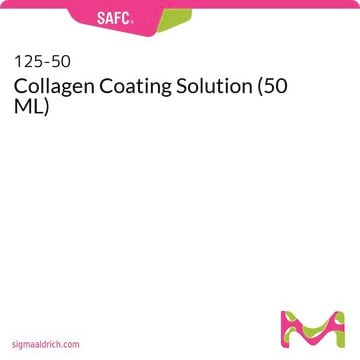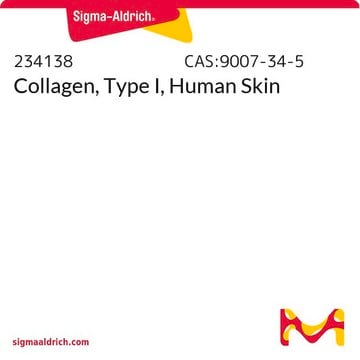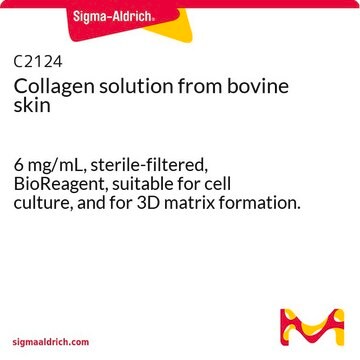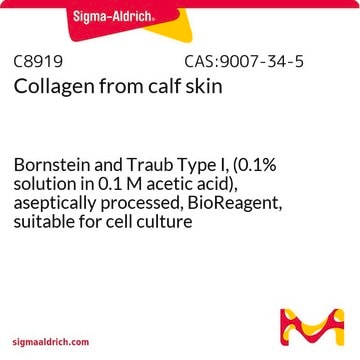As indicated above under 'PROPERTIES', this collagen solution is sterile-filtered.
C2249
Human Collagen Type I
from human fibroblasts, liquid, 3 mg/mL, suitable for cell culture
Synonym(s):
Collagen Solution, Fibroblast Collagen
Select a Size
Select a Size
About This Item
Recommended Products
Product Name
Collagen Solution from human fibroblasts, 3 mg/mL, sterile-filtered, BioReagent, suitable for cell culture
biological source
human fibroblasts
Quality Level
sterility
sterile-filtered
product line
BioReagent
form
solution
packaging
pkg of 20 mL
concentration
3 mg/mL
technique(s)
cell culture | mammalian: suitable
surface coverage
6‑10 μg/cm2
Binding Specificity
Peptide Source: Collagen
Peptide Source: Elastin
foreign activity
endotoxin ≤5.0 μmole/min-mg protein
shipped in
wet ice
storage temp.
2-8°C
General description
Application
Biochem/physiol Actions
Storage Class Code
10 - Combustible liquids
WGK
nwg
Flash Point(F)
Not applicable
Flash Point(C)
Not applicable
Choose from one of the most recent versions:
Already Own This Product?
Find documentation for the products that you have recently purchased in the Document Library.
Customers Also Viewed
Articles
Extracellular matrix proteins such as laminin, collagen, and fibronectin can be used as cell attachment substrates in cell culture.
Extracellular matrix proteins such as laminin, collagen, and fibronectin can be used as cell attachment substrates in cell culture.
Extracellular matrix proteins such as laminin, collagen, and fibronectin can be used as cell attachment substrates in cell culture.
Extracellular matrix proteins such as laminin, collagen, and fibronectin can be used as cell attachment substrates in cell culture.
-
How did you steralize this collagen?
1 answer-
Helpful?
-
-
Is this product suitable for 3D gel formation? How should it be neutralized? How quickly does it polymerize once neutralized? Is there a protocol available for 3D gel formation?
1 answer-
Procedure for 3-D Gel Preparation:
1. Mix 8 parts of chilled collagen solution with 1 part of
10 X PBS (Catalog Number P5493 or P5368) or
10 X culture medium. Cells may be added following
this step.2. Adjust pH of mixture prepared in step 1 to 7.2–7.6.
Use of 0.1 M NaOH (10-fold dilution of Catalog
Number S2770) or 0.01 M HCl (100-fold dilution of
Catalog Number H9892) is recommended. Monitor
pH adjustment carefully with pH meter, phenol red,
or pH paper.3. To prevent gelation, maintain temperature of the
mixture at 2–8C. To form gel, warm to 37C. For
best results allow 45 minutes to 1 hour for gel
formation.4. The gels can be dried under a laminar flow hood.
Helpful?
-
-
What is the 2D Hydrogel protocol for Product No. C2249?
1 answer-
There has been no internal protocol for C2249 however this paper describes protocol for 2D Collagen Gel. Hong H, Stegemann JP. 2D and 3D collagen and fibrin biopolymers promote specific ECM and integrin gene expression by vascular smooth muscle cells. J Biomater Sci Polym Ed. 2008;19(10):1279-93. doi: 10.1163/156856208786052380. PMID: 18854122; PMCID: PMC2731795.
Helpful?
-
-
Is this a monomer?
1 answer-
This product is a mix of monomers, dimers, trimers, and oligomers, with some remaining collagen fragments.
Helpful?
-
-
What solvent is used for product C2249?
1 answer-
The solvent for product C2249 is 13 mM HCl.
Helpful?
-
-
Is the monomer a tropocollagen?
1 answer-
The human collagen is secreted from fibroblast cells, which cleave the loose ends of the procollagen molecule, leaving what is considered tropocollagen with the telopeptide region intact. An enzyme step is utilized to cleave the telopeptide, resulting in Atelocollagen, which maintains its triple helical formation but without the telopeptide region.
Helpful?
-
-
What is the acid, and concentration of acid, that the collagen is solubilized within?
1 answer-
The acid used to prepare this product is HCl. The final concentration of the solvent is 13 mM.
Helpful?
-
Active Filters
Our team of scientists has experience in all areas of research including Life Science, Material Science, Chemical Synthesis, Chromatography, Analytical and many others.
Contact Technical Service